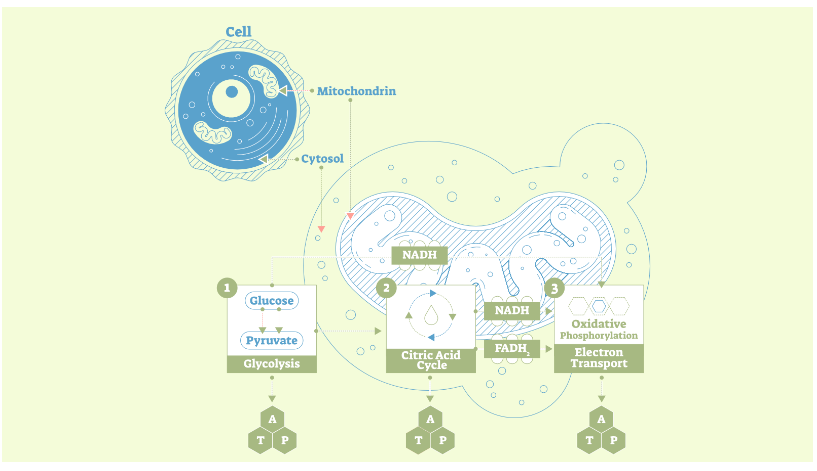Table of Contents
Introduction to Respiration
Respiration is the process by which living organisms convert organic molecules into usable energy. In aerobic respiration, oxygen is utilized to break down organic substances, mostly glucose, generating carbon dioxide, water, and ATP. It partially occurs in the cytoplasm and partially in the mitochondria of cells. Anaerobic respiration occurs in the absence of oxygen, and although it produces less ATP, it allows for energy production in low-oxygen environments. Cellular respiration is crucial for the survival and functioning of organisms, providing the energy needed for various biological processes, including growth, movement, and reproduction. It is a fundamental metabolic process found in animals, plants, and many microorganisms.
Definition of Respiration
Respiration is the biological process through which organisms convert various organic substances, including glucose, fatty acids, and amino acids, into energy. Respiration is essential for sustaining life and supporting cellular functions, growth, and reproduction in living organisms.
Definition of Aerobic Respiration
Aerobic respiration is a cellular process in which organisms convert glucose and oxygen into energy, carbon dioxide, and water. It occurs in the mitochondria and yields a higher amount of energy (ATP) compared to anaerobic processes. Oxygen is crucial for this efficient energy production in eukaryotic organisms.
Common Respiratory Pathway
Glycolysis is the initial step in both aerobic and anaerobic respiration, where glucose is partially broken down in the cytoplasm of cells to generate energy in the form of ATP. This process occurs in all living organisms, from bacteria to humans. During glycolysis, a single molecule of glucose (a 6-carbon compound) is converted into two molecules of pyruvate (a 3-carbon compound).
The overall process of glycolysis can be summarised in two phases:
- Energy Investment Phase: Two ATP molecules are utilized to activate glucose, which is then split into two three-carbon molecules called glyceraldehyde 3-phosphate (G3P).
- Energy Harvesting Phase: Each G3P molecule is oxidized and phosphorylated, resulting in the production of two molecules of NADH and four molecules of ATP. Additionally, the G3P is rearranged to form pyruvate.
At the end of glycolysis, two molecules of pyruvate, two molecules of NADH are produced, with net gain of two ATP molecules. The NADH can be further utilised in subsequent stages of aerobic respiration to generate additional ATP.
Overall, glycolysis is a fundamental metabolic pathway that provides a quick source of energy by breaking down glucose (most common respiratory substrate) into smaller molecules in both aerobic and anaerobic respiration.
Also Check Relevant Topic:
Aerobic Respiration
After glycolysis, if oxygen is available then the cells can perform aerobic respiration.
Link Reaction
Glycolysis is followed by link reaction. The link reaction, also known as the pyruvate decarboxylation, is a metabolic pathway that occurs in the mitochondria. It converts pyruvate, a product of glycolysis, into acetyl-CoA, releasing carbon dioxide and generating NADH in the process. The acetyl-CoA then enters the citric acid cycle for further energy production.
Krebs Cycle
After glycolysis, if oxygen is available, pyruvate generated in the cytoplasm moves into the mitochondria. Within the mitochondrial matrix, each pyruvate molecule undergoes a series of reactions called the Krebs cycle. During the Krebs cycle, each pyruvate is fully oxidized, releasing carbon dioxide and generating high-energy electron carriers (NADH and FADH2). The cycle also produces a small amount of ATP.
Oxidative Phosphorylation
The electron carriers (NADH and FADH2) generated in glycolysis and the Krebs cycle donate their electrons to the electron transport chain, which is embedded in the inner mitochondrial membrane. The electron transport chain consists of a series of protein complexes that shuttle electrons down the chain, releasing energy in the process. This energy is used to pump hydrogen ions (protons) across the inner mitochondrial membrane, creating an electrochemical gradient. Finally, oxygen acts as the final electron acceptor, combining electrons and hydrogen ions to form water. The flow of protons back across the membrane through ATP synthase generates ATP in a process called oxidative phosphorylation.

Frequently Asked Questions on Aerobic Respiration
What is aerobic respiration?
Aerobic respiration is a biological process in which cells use oxygen to convert glucose into energy, producing carbon dioxide and water as byproducts.
Where does aerobic respiration occur?
Aerobic respiration takes place in the mitochondria of eukaryotic cells, specifically in the inner mitochondrial membrane and the matrix.
What are the main stages of aerobic respiration?
Aerobic respiration consists of three main stages: glycolysis, the citric acid cycle (Krebs cycle), and the electron transport chain.
What happens during glycolysis?
Glycolysis is the initial stage of aerobic respiration where glucose is broken down into two molecules of pyruvate. This process occurs in the cytoplasm and yields a small amount of ATP and NADH.
What is the role of the citric acid cycle?
The citric acid cycle is the second stage of aerobic respiration. It takes place in the mitochondria and further breaks down the pyruvate molecules into carbon dioxide, generating NADH and FADH2 as well as some ATP.
How does the electron transport chain work?
The electron transport chain is the final stage of aerobic respiration. It occurs in the inner mitochondrial membrane and involves the transfer of electrons through protein complexes. This process generates a proton gradient that drives the synthesis of ATP through chemiosmotic coupling.
What is the net ATP production in aerobic respiration?
The net ATP production through aerobic respiration varies, but approximately 36 to 38 molecules of ATP are generated per molecule of glucose.








